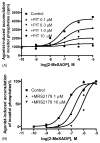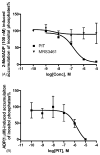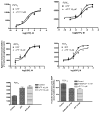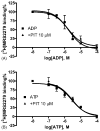2,2'-Pyridylisatogen tosylate antagonizes P2Y1 receptor signaling without affecting nucleotide binding
- PMID: 15193995
- PMCID: PMC4372108
- DOI: 10.1016/j.bcp.2004.02.039
2,2'-Pyridylisatogen tosylate antagonizes P2Y1 receptor signaling without affecting nucleotide binding
Abstract
The effect of 2,2'-pyridylisatogen tosylate (PIT) on the human P2Y(1) receptor and on other recombinant P2Y receptors has been studied. We first examined the modulation by PIT of the agonist-induced accumulation of inositol phosphates. PIT blocked 2-methylthio-ADP (2-MeSADP)-induced accumulation of inositol phosphates in 1321N1 astrocytoma cells stably expressing human P2Y(1) receptors in a non-competitive and concentration-dependent manner. The IC(50) for reduction of the maximal agonist effect was 0.14microM. In contrast, MRS2179, a competitive P2Y(1) receptor antagonist, parallel-shifted the agonist concentration-response curve to the right. PIT also concentration-dependently blocked the P2Y(1) receptor signaling induced by the endogenous agonists, ADP and ATP. A simple structural analogue of PIT was synthesized and found to be inactive as a P2Y(1) receptor antagonist, suggesting that the nitroxyl group of PIT is a necessary structural component for P2Y(1) receptor antagonism. We next examined the possible modulation of the binding of the newly available antagonist radioligand for the P2Y(1) receptor, [3H] MRS2279. It was found that PIT (0.01-10microM) did not inhibit [3H] MRS2279 binding to the human P2Y(1) receptor. PIT (10microM) had no effect on the competition for [3H] MRS2279 binding by agonists, ADP and ATP, suggesting that its antagonism of the P2Y(1) receptor may be allosteric. PIT had no significant effect on agonist activation of other P2Y receptors, including P2Y(2), P2Y(4), P2Y(6), P2Y(11) and P2Y(12) receptors. Thus, PIT selectively and non-competitively blocked P2Y(1) receptor signaling without affecting nucleotide binding.
Figures








Similar articles
-
2-Chloro N(6)-methyl-(N)-methanocarba-2'-deoxyadenosine-3',5'-bisphosphate is a selective high affinity P2Y(1) receptor antagonist.Br J Pharmacol. 2002 Apr;135(8):2004-10. doi: 10.1038/sj.bjp.0704673. Br J Pharmacol. 2002. PMID: 11959804 Free PMC article.
-
Quantitation of the P2Y(1) receptor with a high affinity radiolabeled antagonist.Mol Pharmacol. 2002 Nov;62(5):1249-57. doi: 10.1124/mol.62.5.1249. Mol Pharmacol. 2002. PMID: 12391289 Free PMC article.
-
Antagonists and the purinergic nerve hypothesis: 2, 2'-pyridylisatogen tosylate (PIT), an allosteric modulator of P2Y receptors. A retrospective on a quarter century of progress.J Auton Nerv Syst. 2000 Jul 3;81(1-3):225-7. doi: 10.1016/s0165-1838(00)00142-9. J Auton Nerv Syst. 2000. PMID: 10869725 Review.
-
Potentiation by 2,2'-pyridylisatogen tosylate of ATP-responses at a recombinant P2Y1 purinoceptor.Br J Pharmacol. 1996 Mar;117(6):1111-8. doi: 10.1111/j.1476-5381.1996.tb16704.x. Br J Pharmacol. 1996. PMID: 8882604 Free PMC article.
-
Pharmacological profiles of cloned mammalian P2Y-receptor subtypes.Pharmacol Ther. 2006 Jun;110(3):415-32. doi: 10.1016/j.pharmthera.2005.08.014. Epub 2005 Oct 28. Pharmacol Ther. 2006. PMID: 16257449 Review.
Cited by
-
Signaling of the Human P2Y(1) Receptor Measured by a Yeast Growth Assay with Comparisons to Assays of Phospholipase C and Calcium Mobilization in 1321N1 Human Astrocytoma Cells.Purinergic Signal. 2005 Sep;1(3):241-7. doi: 10.1007/s11302-005-6310-1. Purinergic Signal. 2005. PMID: 16467903 Free PMC article.
-
Medicinal chemistry of adenosine, P2Y and P2X receptors.Neuropharmacology. 2016 May;104:31-49. doi: 10.1016/j.neuropharm.2015.12.001. Epub 2015 Dec 12. Neuropharmacology. 2016. PMID: 26686393 Free PMC article. Review.
-
International Union of Pharmacology LVIII: update on the P2Y G protein-coupled nucleotide receptors: from molecular mechanisms and pathophysiology to therapy.Pharmacol Rev. 2006 Sep;58(3):281-341. doi: 10.1124/pr.58.3.3. Pharmacol Rev. 2006. PMID: 16968944 Free PMC article. Review.
-
Pharmacological characterization of P2Y receptor subtypes - an update.Purinergic Signal. 2024 Apr;20(2):99-108. doi: 10.1007/s11302-023-09963-w. Epub 2023 Sep 12. Purinergic Signal. 2024. PMID: 37697211 Free PMC article. Review.
-
CysLT1 leukotriene receptor antagonists inhibit the effects of nucleotides acting at P2Y receptors.Biochem Pharmacol. 2005 Dec 19;71(1-2):115-25. doi: 10.1016/j.bcp.2005.10.003. Epub 2005 Nov 8. Biochem Pharmacol. 2005. PMID: 16280122 Free PMC article.
References
-
- Ralevic V, Burnstock G. Receptors for purines and pyrimidines. Pharmacol Rev. 1998;50:13–92. - PubMed
-
- Jacobson KA, Jarvis MF, Williams M. Purine and pyrimidine (P2) receptors as drug targets. J Med Chem. 2002;45:4057–93. - PubMed
-
- Lazarowski ER, Boucher RC, Harden TK. Mechanisms of release of nucleotides and integration of their action as P2X- and P2Y-receptor activating molecules. Mol Pharmacol. 2003;64:785–95. - PubMed
-
- Hechler B, Vigne P, Leon C, Breittmayer JP, Gachet C, Frelin C. ATP derivatives are antagonists of the P2Y1 receptor: similarities to the platelet ADP receptor. Mol Pharmacol. 1998;53:727–33. - PubMed
-
- Palmer RK, Boyer JL, Schachter JB, Nicholas RA, Harden TK. Agonist action of adenosine triphosphates at the human P2Y1 receptor. Mol Pharmacol. 1998;54:1118–23. - PubMed
MeSH terms
Substances
Grants and funding
LinkOut - more resources
Full Text Sources
Molecular Biology Databases

